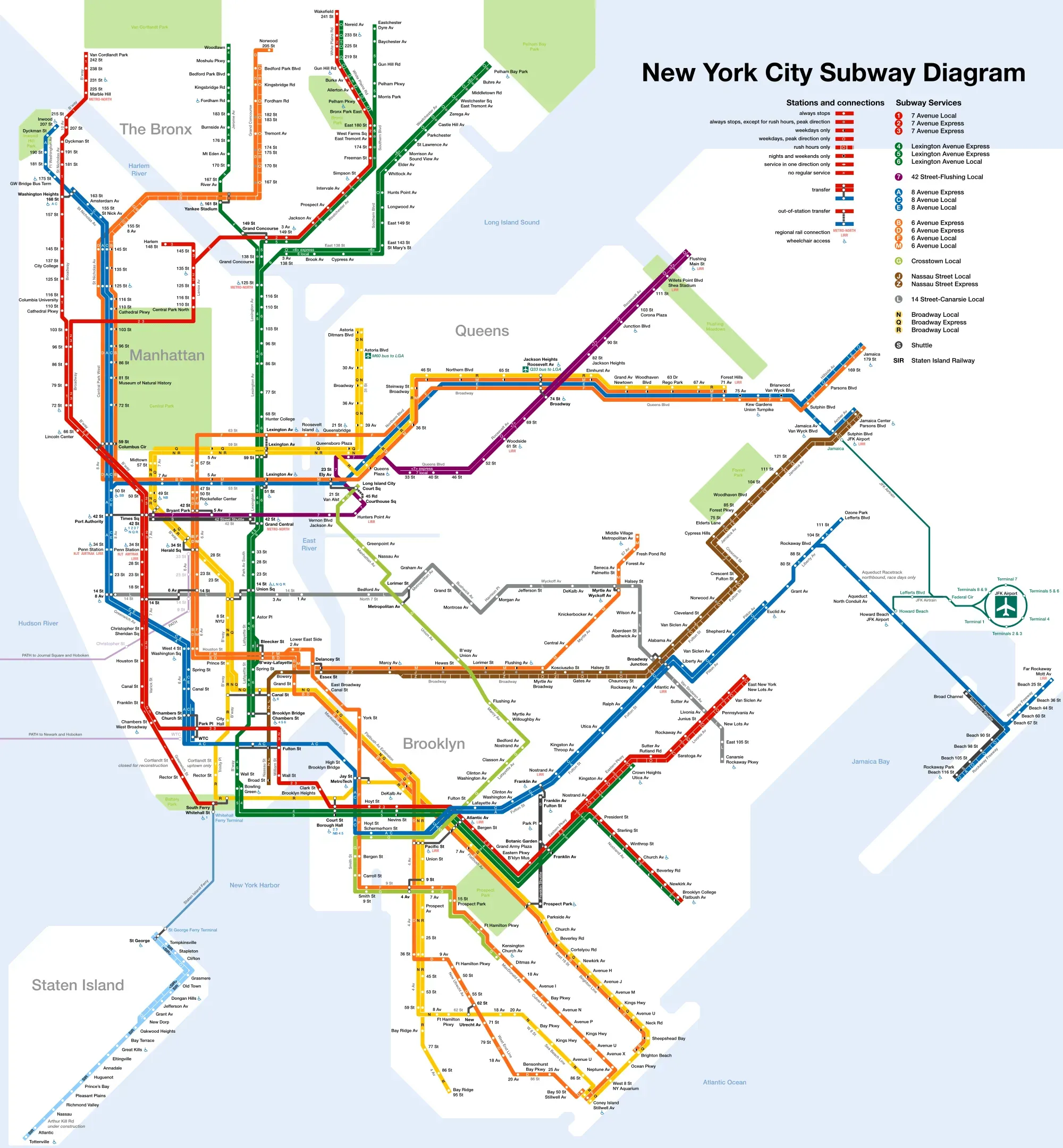New York City Subway Map: MTA’s First Redesign in 45 Years

The New York City subway map has undergone a remarkable transformation with the recent unveiling of the MTA’s first major redesign in over 45 years. Marking a departure from the traditional spaghetti diagram style, the new subway map prioritizes simplicity and clarity, making it easier to navigate the extensive transit system. Bold colors and clear labeling not only enhance visibility but also reflect the numerous improvements made to the subway lines, including features like the 2nd Avenue Subway and Roosevelt Island’s F train stop. As the MTA prepares for significant changes in 2025, this updated subway map is an essential tool for both everyday commuters and tourists alike. Stay tuned for New York transit updates, as these enhancements promise to improve subway navigation for everyone.
The latest iteration of New York’s underground transit map embodies the MTA’s commitment to providing a modern travel experience. This redesigned guide showcases the city’s extensive rail network with an emphasis on usability, helping riders to find their way through the bustling metropolitan area with ease. The MTA subway map now reflects a contemporary aesthetic while retaining elements carefully influenced by historical designs. Additionally, upcoming MTA changes in 2025 will continue to enhance the functionality of this vital navigation tool. This fresh take on subway mapping epitomizes the evolution of transit design, ensuring that both long-time residents and first-time visitors can navigate New York City’s vast subway system effectively.
Overview of the New York City Subway Map Redesign
The MTA has launched a groundbreaking new subway map for New York City, marking the first major redesign in 45 years. This initiative aims to elevate the overall customer experience, making navigation within the subway system more intuitive. Presenting the subway lines with increased clarity rather than focusing on geographical accuracy, the new design helps riders easily identify their routes. The updated map’s bold color scheme and simplified layout enhance visibility, a necessity for both everyday commuters and first-time users navigating the extensive NYC transit network.
Reflecting on its design legacy, the new subway map draws inspiration from Massimo Vignelli’s iconic 1972 creation while incorporating contemporary elements from previous versions. This modernization serves not just functional purposes but also pays homage to the rich history of the MTA. With features such as clearer indicators for transfer points and easily identifiable accessible stations, the map represents a significant step forward in making subway navigation better for everyone.
Key Features of the MTA Subway Map
One of the standout features of the new MTA subway map is its focus on readability and user experience. The redesign prioritizes the subway lines, making them the centerpiece of the map, which helps reduce the complexity often associated with navigating NYC streets. Riders can now locate vital connections between trains without being distracted by extraneous geographical details. Such improvements in subway navigation can drastically enhance transit efficiency, especially during peak hours or service changes.
Additionally, the map showcases new transit developments that were absent in prior versions. Key additions like the 2nd Avenue Subway and the F train stop on Roosevelt Island are now accurately represented, ensuring that regular riders and newcomers alike have up-to-date information. Moreover, the MTA’s commitment to accessibility shines through as prominent features highlighting these stations are easily visible, reinforcing their dedication to inclusivity.
How the New Map Enhances Navigation
With the updated subway map, riders can expect a significant improvement in navigation, especially for those unfamiliar with the city. The design streamlines the process of planning trips across a vast network of subway lines, eliminating confusion that arose from the old ‘spaghetti diagram’ styling. Each subway line stands out with distinct colors, allowing users to quickly ascertain their routes and transfers. Enhanced legibility combined with a clean layout empowers riders to traverse the city with confidence.
Furthermore, accessibility features are integral to the new MTA subway map. Riders can swiftly identify accessible stations and understand their options when planning their journeys. The MTA is actively improving how updates are communicated, ensuring that real-time transit updates are more accessible to all users. This thoughtful integration of features makes a monumental difference in the everyday experience of navigating New York City’s intricacies.
The Importance of the New York City Subway Map
The New York City subway map is not merely a tool for navigation; it is a cultural icon that embodies the spirit of the city. Its redesign comes at a crucial time when travel patterns are evolving and new subway lines are being introduced. The updated version reflects the MTA’s ongoing efforts to enhance service and adapt to the changing needs of its ridership, signifying a commitment to modernity and quality.
Moreover, as the city continues to grow, the significance of clear and efficient transit communication cannot be overstated. The new subway map serves not only the purpose of navigating the subway system but also acts as an ambassador of New York’s unique character and history. Tourists and locals alike will appreciate the blend of tradition and innovation encapsulated in this new design, making the New York City subway experience all the more remarkable.
MTA Changes and Future Transit Updates
As part of the MTA’s ongoing evolution, this new subway map aligns with several anticipated changes set for 2025. Moving beyond design aesthetics, the MTA is implementing practical upgrades that include real-time service updates and enhancements in commuter safety. With features like instant notifications on service changes visible on the new subway map, riders can stay informed and make timely decisions as they travel.
Future updates are expected to further integrate technology into the transit experience, promising continuous improvements in how riders interact with the subway system. The MTA’s modernization plans will not only make the experience smoother but also more enjoyable, giving commuters more confidence in their everyday journeys. As these developments unfold, riders can rely on the subway map as a constant companion in their daily lives.
Navigating the MTA Subway System with Ease
The redesigned New York City subway map signifies a transformative approach to subway navigation that prioritizes user experience above all. For both regular commuters and infrequent riders, this new format facilitates easier understanding of connections and routes. The emphasis on clear visual language makes it possible for people of all ages to grasp the necessary information quickly, enhancing their overall transit experience.
As individuals adapt to the new layout, the potential for reduced travel time increases. Enhanced clarity around transfer points means less confusion when switching lines, which is particularly beneficial during busy rush hours. Essentially, the MTA subway map is an essential tool that not only helps in navigating the complexities of the subway system but also elevates the commuting experience in one of the world’s most dynamic cities.
The Aesthetic Appeal of the New Subway Map
Beyond functionality, the new MTA subway map brings a refreshing aesthetic that resonates with New York City’s vibrant identity. With its bold colors and simplified lines, the map captures the essence of the city while still being deeply rooted in tradition. The focus on visually appealing elements can attract both locals and tourists, encouraging them to engage more actively with the subway system.
The chosen color palette reflects both the modern urban landscape of New York and respects historical influences from past map designs. By bridging this gap, the MTA successfully presents a map that is not only useful for navigation but also an artistic representation of the city. Such thoughtful design enhances the landmark character of the subway system, making every journey an experience enriched by both visual delight and practicality.
Impact of the New Map on Community Engagement
The launch of the new subway map is also expected to strengthen community engagement within New York City. By involving local artists and designers in the redesign process, the MTA created a map that resonates with the broader community. This collaboration encourages a sense of ownership and pride among residents as they see their contributions reflected in something as iconic as the subway map.
Moreover, the map serves as a launching pad for further discussions about public transit improvements and urban design. With civic pride and active participation in transit dialogue, residents can influence the future directions of city planning. The MTA aims to foster open communication channels that not only inform the public about transit updates but also invite them to be part of an ongoing narrative surrounding New York’s ever-evolving transit system.
Looking Forward: Future Developments in New York Transit
As New York City gears up for the future, the new subway map lays the groundwork for additional innovations in the transit system. The MTA is committed to examining user feedback and data analytics to identify areas for improvement and expansion of services. Future changes slated for 2025 aim to incorporate technological enhancements, making the subway system more responsive to the needs of its passengers.
In addition to ongoing map adjustments, the MTA plans to facilitate smoother travel with better connectivity among various transit options, integrating bus and ferry services more effectively. As development trails unfold, the subway map will continue to evolve, ensuring that it remains an indispensable tool that keeps pace with New York City’s growth and complexity. This proactive approach signifies the MTA’s dedication to creating a transit experience that prioritizes convenience and efficiency, staying ahead of the curve in urban transportation.
Frequently Asked Questions
What are the main features of the new New York City subway map?
The new New York City subway map, unveiled by the MTA, emphasizes subway lines over geographical accuracy, making it easier to read. Key features include bold colors, clear indications of accessible stations, and easily identifiable transfer points. This redesign, the first in 45 years, borrows from earlier designs while incorporating the latest expansions, such as the 2nd Avenue Subway and recent MTA changes.
How does the MTA subway map redesign improve navigation for riders?
The MTA subway map redesign focuses on enhancing subway navigation improvements. By prioritizing the clarity of subway lines and significant features like accessible station symbols, riders find it easier to navigate, especially during service changes. This user-focused approach aims to facilitate a better commuting experience for both regular users and newcomers to the system.
When will the new MTA subway map be available throughout New York City?
The new MTA subway map will be gradually rolled out into subway cars and stations over the coming months. Currently, it is displayed on the 42nd Street Shuttle line, with plans to implement it across the entire subway system. This rollout is part of a broader initiative for New York transit updates aimed at modernizing public transport in the city.
What inspired the design of the new New York City subway map?
The design of the new New York City subway map was inspired by Massimo Vignelli’s geometric subway map from 1972. While the current design maintains the iconic look of previous maps from 1979 and 1998, it brings a contemporary twist that redefines how riders visualize the subway lines, enhancing usability for the 21st-century commuter.
What changes have been made to the subway navigation in the MTA changes 2025?
The MTA changes in 2025 include the latest subway map redesign that simplifies navigation through clear line emphasis and enhanced visibility of transit features. New elements, such as the 2nd Avenue Subway and improved indicators for accessible stations, reflect the evolutions in the subway system over the past few decades, ensuring a better travel experience for users.
| Key Point | Details |
|---|---|
| First New Subway Map in 45 Years | Unveiled by MTA on April 2, 2025, emphasizing readability over geographical accuracy. |
| Design Inspiration | Inspired by Massimo Vignelli’s 1972 map and retains brand colors from 1979 and 1998 maps. |
| Improved Readability | The new map uses bold colors and a simpler design for easier navigation. |
| Modern Enhancements | Includes new subway features like the 2nd Avenue Subway and updated transfer points. |
| Accessibility Features | Accessible stations clearly marked, aiding both regular and new users in navigation. |
| Implementation Timeline | Map currently displayed on the 42nd Street Shuttle, with rollout planned for all stations over months. |
Summary
The New York City subway map has undergone a significant transformation, marking the first redesign in 45 years. This fresh map simplifies commuter navigation by focusing on the subway lines with bold colors, making it much easier for riders to understand the system. With enhanced features for accessibility and modern design elements that pay tribute to iconic previous maps, the new New York City subway map is set to become an indispensable tool for both everyday commuters and tourists alike.




